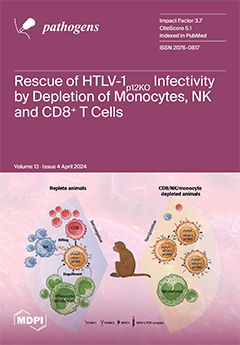The objective of this study was the presentation of quantitative characteristics regarding the scientific content and bibliometric details of the relevant publications. In total, 156 papers were considered. Most papers presented original studies (
n = 135), and fewer were reviews (
n = 21). Most original articles (
n = 101) referred to work involving cattle. Most original articles described work related to the diagnosis (
n = 72) or pathogenesis (
n = 62) of mastitis. Most original articles included field work (
n = 75), whilst fewer included experimental (
n = 31) or laboratory (
n = 30) work. The tissue assessed most frequently in the studies was milk (
n = 59). Milk was assessed more frequently in studies on the diagnosis (61.1% of relevant studies) or pathogenesis (30.6%) of the infection, but mammary tissue was assessed more frequently in studies on the treatment (31.0%). In total, 47 pathogens were included in the studies described; most were Gram-positive bacteria (
n = 34). The three bacteria most frequently included in the studies were
Staphylococcus aureus (
n = 55 articles),
Escherichia coli (
n = 31) and
Streptococcus uberis (
n = 19). The proteomics technology employed more often in the respective studies was liquid chromatography-tandem mass spectrometry (LC-MS/MS), either on its own (
n = 56) or in combination with other technologies (
n = 40). The median year of publication of articles involving bioinformatics or LC-MS/MS and bioinformatics was the most recent: 2022. The 156 papers were published in 78 different journals, most frequently in the
Journal of Proteomics (
n = 16 papers) and the
Journal of Dairy Science (
n = 12). The median number of cited references in the papers was 48. In the papers, there were 1143 co-authors (mean: 7.3 ± 0.3 co-authors per paper, median: 7, min.–max.: 1–19) and 742 individual authors. Among them, 15 authors had published at least seven papers (max.: 10). Further, there were 218 individual authors who were the first or last authors in the papers. Most papers were submitted for open access (
n = 79). The median number of citations received by the 156 papers was 12 (min.–max.: 0–339), and the median yearly number of citations was 2.0 (min.–max.: 0.0–29.5). The
h-index of the papers was 33, and the
m-index was 2. The increased number of cited references in papers and international collaboration in the respective study were the variables associated with most citations to published papers. This is the first ever scientometrics evaluation of proteomics studies, the results of which highlighted the characteristics of published papers on mastitis and proteomics. The use of proteomics in mastitis research has focused on the elucidation of pathogenesis and diagnosis of the infection; LC-MS/MS has been established as the most frequently used proteomics technology, although the use of bioinformatics has also emerged recently as a useful tool.
Full article


